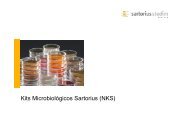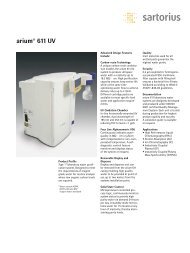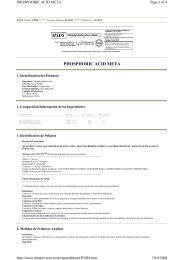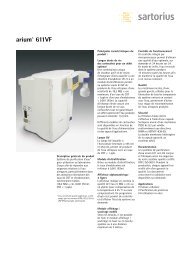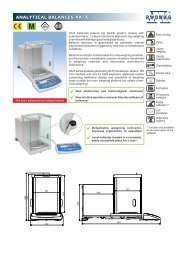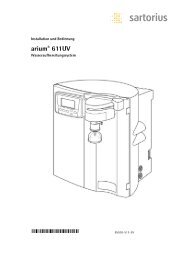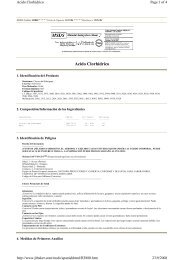Material Safety Data Sheet
Material Safety Data Sheet
Material Safety Data Sheet
You also want an ePaper? Increase the reach of your titles
YUMPU automatically turns print PDFs into web optimized ePapers that Google loves.
http://fscimage.fishersci.com/msds/00650.htm<br />
Page 2 of 5<br />
23/9/2008<br />
Never give anything by mouth to an unconscious person. Get medical aid.<br />
Inhalation: If inhaled, remove to fresh air. If not breathing, give artificial respiration. If<br />
breathing is difficult, give oxygen. Get medical aid.<br />
Notes to Physician: Treat symptomatically and supportively.<br />
Section 5 - Fire Fighting Measures<br />
General Information: As in any fire, wear a self-contained breathing apparatus in pressuredemand,<br />
MSHA/NIOSH (approved or equivalent), and full protective gear. During a fire, irritating<br />
and highly toxic gases may be generated by thermal decomposition or combustion. This material<br />
in sufficient quantity and reduced particle size is capable of creating a dust explosion.<br />
Extinguishing Media: Use water spray, dry chemical, carbon dioxide, or appropriate foam.<br />
Flash Point: Not applicable.<br />
Autoignition Temperature: 375 deg C ( 707.00 deg F)<br />
Explosion Limits, Lower:N/A<br />
Upper: N/A<br />
NFPA Rating: (estimated) Health: 2; Flammability: 1; Instability: 1<br />
Section 6 - Accidental Release Measures<br />
General Information: Use proper personal protective equipment as indicated in Section 8.<br />
Spills/Leaks: Vacuum or sweep up material and place into a suitable disposal container. Avoid<br />
generating dusty conditions. Provide ventilation.<br />
Section 7 - Handling and Storage<br />
Handling: Wash thoroughly after handling. Remove contaminated clothing and wash before<br />
reuse. Use with adequate ventilation. Minimize dust generation and accumulation. Avoid contact<br />
with eyes, skin, and clothing. Avoid breathing dust.<br />
Storage: Store in a cool, dry, well-ventilated area away from incompatible substances. Keep<br />
containers tightly closed.<br />
Section 8 - Exposure Controls, Personal Protection<br />
Engineering Controls: Use adequate ventilation to keep airborne concentrations low.<br />
Exposure Limits<br />
Chemical Name ACGIH NIOSH OSHA - Final PELs<br />
Fumaric acid none listed none listed none listed<br />
OSHA Vacated PELs: Fumaric acid: No OSHA Vacated PELs are listed for this chemical.<br />
Personal Protective Equipment<br />
Eyes: Wear appropriate protective eyeglasses or chemical safety goggles as described by<br />
OSHA's eye and face protection regulations in 29 CFR 1910.133 or European Standard EN166.<br />
Skin: Wear appropriate gloves to prevent skin exposure.<br />
Clothing: Wear appropriate protective clothing to minimize contact with skin.<br />
Respirators: Follow the OSHA respirator regulations found in 29 CFR 1910.134 or European<br />
Standard EN 149. Use a NIOSH/MSHA or European Standard EN 149 approved respirator if<br />
exposure limits are exceeded or if irritation or other symptoms are experienced.




